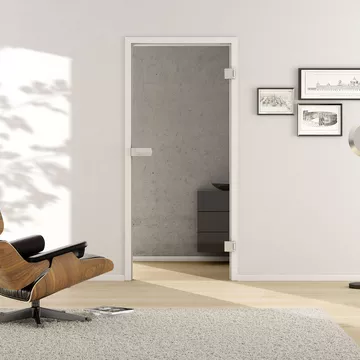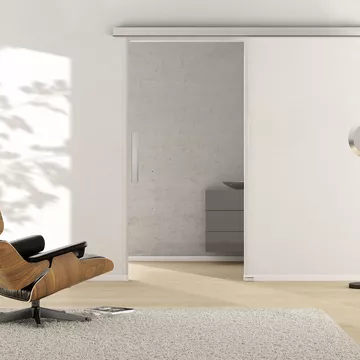Biophilic Design - Nature concept for interiors
The green living concept brings the feel-good atmosphere of Nature indoors. Reduce stress and promote relaxation: Green planted walls, water and natural materials create the nature-based interior design style.
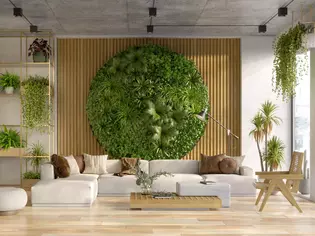
What is Biophilic Design?
The term "biophilia" is derived from the Greek word "bio", meaning "life", and "philia", meaning "love". The U.S. biologist E.O. Wilson popularized the term in the 1980s. He explained how important nature was for people and their well-being. Especially in cities, the proximity to nature is missing. Green spaces are few and far between, unlike in rural areas. Bringing Nature Indoors: Biophilic design furnishings create a living feeling close to nature. Words like, forest bathing and healing powers of Nature, could be read more often in the media in recent years. Also in architecture and interior design, the reference to nature is increasingly taken up.
Natural Patterns and Biophilic Design
Through Biophilic Design, Nature now comes into our interiors to bring the calming effects of nature there as well. Tree bark, untreated Wood and moss weave highlight the natural design. Better yet, if you also want to pay attention to sustainability, use regional Wood and plants. Other materials can include: leather, wool, natural stone, linen fabric, raffia, bamboo, etc. Forms in Biophilic Design are organic and Lines are not straight.
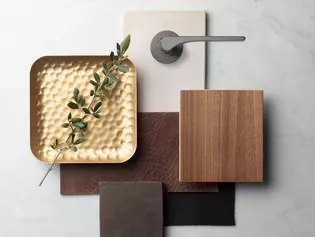
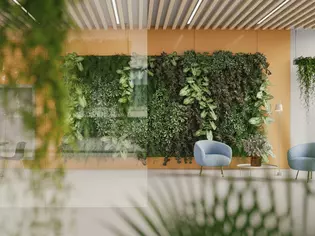
Spatial functionality: creating green living oases
The choice of colors in Biophilic Design is as close to nature as possible. That is, all the shades that are also found in Nature, can also be found in the interiors. Green tones, earthy colors, a natural Yellow and gray tones - natural colors create a cozy atmosphere. Biophilic design supports the concept of space. Green, nature-based offices, have a calming effect and increase the climate of well-being. Entire walls can be covered in natural stone and moss wicker, bringing a forest feel to the workplace. Sounds and scents of nature also play a role in Biophilic Design. Fountains provide a pleasant splashing of water. Earth, moss or natural essential oils also give off a forest smell indoors.
Furniture and Deco Materials in Biophilic Design
Furniture made of natural materials, such as Wood, goes very well with green furniture design. Here, too, the materials are as natural as possible and the forms are organically shaped. Chairs that look like leaves or modern seating made of natural stone and wooden trunks. Biophilic design furniture looks and feels natural. Deco items are also from Nature. Wooden discs, plants or dried flowers, branches and all kinds of natural materials are suitable Deco items. Furniture looks especially good on natural floors. Stone floors or floors with wooden planks are natural materials.
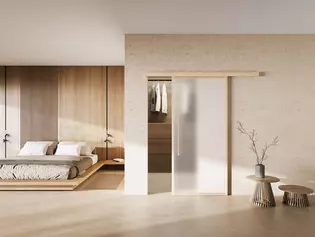
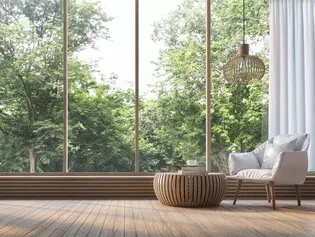
Natural light in Biophilic Design
Lots of daylight is ideal in the Biophilic Design, of course. Large windows and light panels in the roofs make this possible. Glazed conservatories open up views of the green surroundings and make it feel like you're living in the middle of the forest. Indirect light within the rooms, can make darker homes shine naturally bright. The important thing here is to use warm gold light. Too white bulbs, look cold and therefore uncomfortable. Glass doors can also be another way to bring light into the interior and make the rooms look larger. GRIFFWERK's CLARITY 510 Stop glass door in clear glass is timeless and modern, and fits well with Biophilic design. Large Sliding doors made of Glass allow even more daylight into interior spaces. Griffwerk also offers various Sliding door models and systems for this purpose.
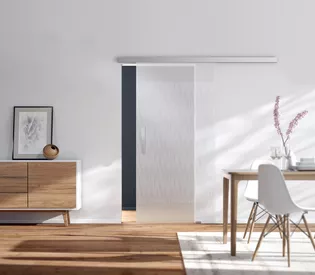
Glass doors as a link between inside and outside
One of the most intriguing ways to incorporate Biophilic design is through the use of Glass doors. Glass doors allow for visual connections to the natural environment outside of a room, while maintaining a clear spatial separation. These doors allow daylight to enter the space unimpeded, creating a connection to the ever-changing outside world.
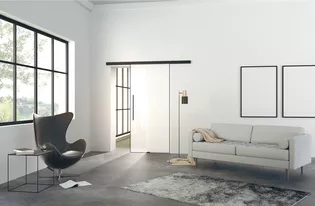
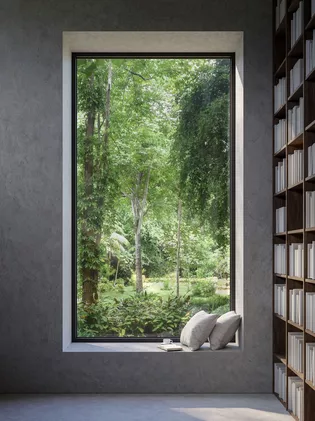
Advantages of Glass doors in Biophilic design
- Natural light: Glass doors maximize the entry of natural light, which not only reduces energy costs, but also has a positive effect on people's mood and productivity.
- View and connection to nature: Glass doors allow occupants or users of a space to view the outside environment and maintain a deep connection to nature without having to physically go outside.
- Psychological well-being: Seeing plants, trees and natural landscapes through Glass doors can reduce stress, enhance creativity and increase an overall sense of well-being.
- Sense of space: Glass doors create a sense of space and openness, making rooms feel larger and more inviting.
Glass doors can be used in a variety of spaces and contexts, from homes to offices to public spaces. In residential spaces, they can create a seamless transition between living and garden areas. In offices, they encourage collaboration by increasing natural light and creating an open work environment. In hotels, shopping malls, and other public spaces, Glass doors allow visitors to experience the beauty of their surroundings while inside.
Biophilic design combined with Glass doors shows us how architecture and Nature can merge to create spaces that are not only functional, but also inspiring. Using Glass doors as a means to experience the natural environment indoors highlights the importance of a balanced lifestyle that brings people into close contact with Nature.
